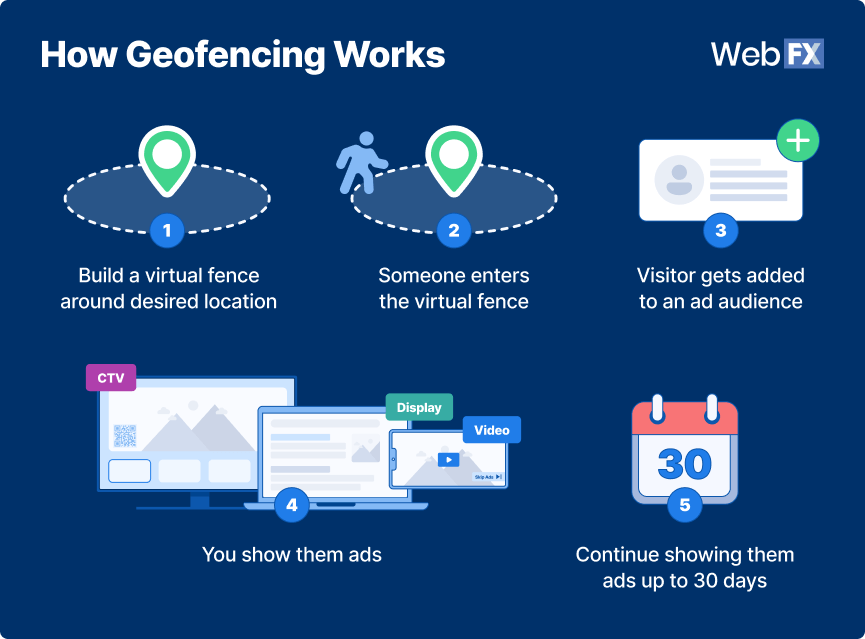-
 7 min. read
7 min. read
-
 Sam Wixted
Sam Wixted Content Writer
Content Writer
- Sam has been writing for WebFX since 2016 and focuses on UX, crafting amazing website experiences, and digital marketing In her free time, she likes to spend time on the beach, play with her cats, and go fishing with her husband.
If you’re pleasantly surprised with the local ads you’ve seen lately, geofencing technology could be to blame. Competitor geofencing is a marketing strategy that has taken businesses by storm.
Geofencing technology allows businesses to target their most qualified audience by simply providing virtual boundaries. When target customers step into that boundary, they activate ads or push notifications for a specific business — enticing potential customers within that boundary to visit a storefront.
It sounds like a story straight out of a science fiction magazine, but it’s actually real life — and more and more businesses use the technology every day. Geofencing technology can be used on Facebook, with PPC ads, and so much more. But how does it work?
In this post, we’ll take a look into the world of geofencing technology and talk about how it can work for your business.
What is geofencing technology?
A location-based marketing strategy, geofencing technology uses GPS signals to determine when a target customer enters a boundary.
Businesses set boundaries around locations where they want to target customers near their physical locations, and they can be set up virtually anywhere. Geofencing is an extremely granular marketing strategy that allows businesses to target customers based on where they are in relation to that business. Typically, businesses set up geofences around a particular business, specific event, or even a conference.

It all depends on who the business wants to target.
To provide a geofencing example, if a business has a sale, and they want to let potential customers know, they could set up an automated text message for when that customer enters the geofence. If there is a specific event that attracts potential customers in your target market, you can set up a geofence around that event and target attendees with your ads, push notifications, or text messages.
What is a geofence?
When a business decides to use geofencing technology, it means they’re looking to specifically target an audience within a certain boundary. That boundary is completely invisible and is created using GPS technology.
It’s easiest to image when thought of as a fence because on a GPS map, that’s what it looks like!
How does geofencing technology work?
Geofencing technology works by creating virtual boundaries, or geofences, that use GPS signals to target specific customers within the defined area. When a customer enters the geofence, they are served ads, push notifications, or text messages tailored to their interests, encouraging them to visit a nearby business or event.
How does geofencing target my specific audience?
Geofencing targets your most qualified audience by serving them ads for your products and services when they step inside your geofence. Those advertisements could take the form of push notifications, text messages, or PPC ads served in a web browser.
Example of geofencing with push notifications
Let’s say that you’ve just opened a women’s boutique and created a shopping app to go with it.
When users download your app, and you also have a geofencing campaign, you can opt to serve them push notifications when they’re in your area. A push notification is a message that appears on your smartphone screen via an app — but the app doesn’t have to be open to receive push notifications. For example, if you’re having a sale on jeans, and someone with your app walks by, a push notification will appear that lets them know about your promotion.
Example of geofencing with text messages
If you obtain your customers’ contact information, including their phone number, you can target them with text messages, too.
If you’re using geofencing technology, you can send an automated text message to your customers when they’re in your geofence location. It could be to let them know about a sale you’re having, what’s new in your store, or just reminding them that they’re close to one of your locations.
Example of geofencing with PPC ads
A typical PPC campaign is a great way to reach target customers. Platforms like Google Ads offer location targeting, which is similar to geofencing — just without the virtual boundaries.
Ads work very similarly for geofencing — except the ads become available when a potential customer physically crosses into one of the geofences. For example, let’s say you own a seafood restaurant. A couple walks down your block, and they’re in search of the best crab legs in town.
You know you’re one of the few seafood restaurants in the area, and you want to target the keyword “crab legs” in your ads. Your restaurant uses geofencing technology to place a box around a three-block radius in every direction from your location. This means that your ads are served to patrons who search for keywords that you target while they’re in your vicinity.
However, just because you target specific keywords in your campaign doesn’t mean that your customers will automatically see your ads. You first have to determine how much you’re willing to pay when someone clicks on your ad that targets a specific keyword, and if it’s less than your competitors, your ad won’t be visible to passersby. So in short, geofencing serves ads to your target customers within your invisible boundary — if you outbid your competitors for a specific keyword.
How accurate is geofencing?
To ensure that geofences are as accurate as possible, the technology utilizes a combination of GPS, cellular data and Wi-Fi data.
In environments where cell phone towers and Wi-Fi routers are everywhere — urban environments provide a good example — the accuracy of geofencing can reach anywhere from 100 to 200 meters.  In rural areas where there aren’t as many towers or Wi-Fi hotspots, accuracy can reach a few hundred meters. Keep in mind that geofencing will always work best when you enable a smartphone’s Wi-Fi enabled and activate GPS services.
In rural areas where there aren’t as many towers or Wi-Fi hotspots, accuracy can reach a few hundred meters. Keep in mind that geofencing will always work best when you enable a smartphone’s Wi-Fi enabled and activate GPS services.
How expensive is geofencing technology?
Many businesses are quick to adopt this new form of marketing, but one of the first questions they have is “how much does it cost?” Being that geofencing is a newer strategy to the market, it’s difficult to put an exact price tag on the service.
Not to mention, every agency is different and tends to charge different amounts for services. However, there are a few things that can help you determine how much a geofencing campaign will cost your company.
How much do you want to pay per month for ads?
If you’re opting to use PPC ads for your geofencing campaign, you’ll need to decide how much you’re willing to spend on ads per month. If you’re targeting keywords that are more specific and long-tail, you’ll likely pay much less than you would if you want to target more general keywords.
That’s because there’s a much higher concentration of general keywords, which means more competition and a higher cost-per-click. A good estimate for monthly ad spend for a geofencing campaign is anywhere from $1000 to upwards of $10,000, depending on your industry and competition.
How many business locations do you have?
The cost of your geofencing campaign can also fluctuate depending on how many locations your business has. For example, if you want to drive leads to five main franchise business locations with geofencing, you’ll pay for each of those locations.
That being said, the fewer locations you have, the cheaper the campaign.
Do you need geofencing services?
If you’re interested in geofencing services for your business, WebFX can help!
Contact us online or give us a call at 888-601-5359 to learn more!
-
 Sam has been writing for WebFX since 2016 and focuses on UX, crafting amazing website experiences, and digital marketing In her free time, she likes to spend time on the beach, play with her cats, and go fishing with her husband.
Sam has been writing for WebFX since 2016 and focuses on UX, crafting amazing website experiences, and digital marketing In her free time, she likes to spend time on the beach, play with her cats, and go fishing with her husband. -

WebFX is a full-service marketing agency with 1,100+ client reviews and a 4.9-star rating on Clutch! Find out how our expert team and revenue-accelerating tech can drive results for you! Learn more
Try our free Marketing Calculator
Craft a tailored online marketing strategy! Utilize our free Internet marketing calculator for a custom plan based on your location, reach, timeframe, and budget.
Plan Your Marketing Budget

Proven Marketing Strategies

Proven Marketing Strategies
Try our free Marketing Calculator
Craft a tailored online marketing strategy! Utilize our free Internet marketing calculator for a custom plan based on your location, reach, timeframe, and budget.
Plan Your Marketing Budget





